Online Massage Therapy Training and Continuing Education
We are honored to have our online massage therapy training courses listed in Massage & Fitness Magazine’s list of Continuing Education courses in North America that that are up-to-date on the latest understanding of pain, movement, and touch based on good science and humanities.
Continuing Education
The Neuroscience of Pain, Posture, and Bodywork
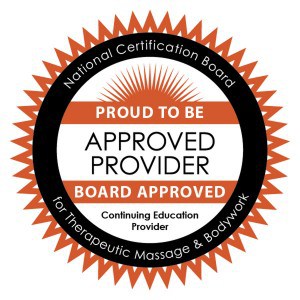 Description: In this online professional development class, an up-to-date neuroscientific approach to posture and pain will be explored and contrasted with the common, outdated, tissue-based approach that is promoted in most manual and movement therapies and the culture at large. Students will learn the latest in the neuroscience of pain, with particular emphasis on the difference between nociception and pain, the process of descending modulation, and the role of psychosocial influences on chronic pain. The course consists of a one-hour lecture video (asynchronous) that serves as prerequisite material for the eight-hour interactive (synchronous) portion of the class. Interactive exercises include how to simply and accurately describe and discuss pain and posture with clients, how to avoid inducing nocebo effects in our clients, and how to simply and accurately describe to clients what one does and why it’s effective.
Description: In this online professional development class, an up-to-date neuroscientific approach to posture and pain will be explored and contrasted with the common, outdated, tissue-based approach that is promoted in most manual and movement therapies and the culture at large. Students will learn the latest in the neuroscience of pain, with particular emphasis on the difference between nociception and pain, the process of descending modulation, and the role of psychosocial influences on chronic pain. The course consists of a one-hour lecture video (asynchronous) that serves as prerequisite material for the eight-hour interactive (synchronous) portion of the class. Interactive exercises include how to simply and accurately describe and discuss pain and posture with clients, how to avoid inducing nocebo effects in our clients, and how to simply and accurately describe to clients what one does and why it’s effective.PCAB graduates who graduated in 2019 or later are not required to take this course to receive Trauma-informed certification, but they are still encouraged to take it since it contains newer exercises than what was provided in the 808-hour program.
Objectives: By the end of this course, participants will be able to:
- Compare and contrast a tissue-centric approach on posture and pain with a neuroscientific approach.
- Describe why a tissue-centric approach to posture and pain is inaccurate and harmful.
- Describe the difference between nociception and pain.
- Describe descending modulation and its relevance to pain.
- List psychosocial and relational influences that can increase or decrease a client’s experience of pain.
- Formulate new ways of speaking with clients that avoid inducing nocebo effects.
- Reformulate, in neuroscientifically-appropriate terms, how they describe and discuss posture and pain with clients.
- Reformulate, in neuroscientifically-appropriate terms, how they describe to clients what they do and why it’s effective.
Trauma-informed Care
 Description: This online course provides critical knowledge and skills necessary to make one’s manual therapy practice trauma-informed. Topics include the characteristics of a trauma-informed bodywork practice, how trauma relates to one’s scope of practice, the neurological and psychological basis for shock and developmental trauma, and how to recognize and respond to trauma with appropriate relational skills that prevent re-traumatization by promoting implicit safety, intersubjectivity, and client agency. The course is comprised of 10% Powerpoint lecture-discussion and 90% of interactive exercises in breakout rooms to ensure that participants gain practical, real-world skills to integrate into their practice. The course also includes two 1-hour videos by the instructor that serve as prerequisite material prior to the 13-hour synchronous/interactive class.
Description: This online course provides critical knowledge and skills necessary to make one’s manual therapy practice trauma-informed. Topics include the characteristics of a trauma-informed bodywork practice, how trauma relates to one’s scope of practice, the neurological and psychological basis for shock and developmental trauma, and how to recognize and respond to trauma with appropriate relational skills that prevent re-traumatization by promoting implicit safety, intersubjectivity, and client agency. The course is comprised of 10% Powerpoint lecture-discussion and 90% of interactive exercises in breakout rooms to ensure that participants gain practical, real-world skills to integrate into their practice. The course also includes two 1-hour videos by the instructor that serve as prerequisite material prior to the 13-hour synchronous/interactive class.
- Neuroscience, Trauma, and Implicit Safety
- Shock Trauma and Autonomic First Aid Skills
- Developmental Trauma and Therapeutic Relationship Skills
- Common Factors in Therapeutic Settings
- Somatic Psychology and Retraumatization
- Supporting and Accepting Client Defenses
- Colluding vs. Cheerleading vs. Agency
Objectives: By the end of this course, participants will be able to:
- Describe the characteristics of a trauma-informed practice.
- Describe how trauma relates to one’s scope of practice.
- Describe implicit safety and why it’s important to maintain it.
- Contrast shock and developmental trauma.
- Identify shock trauma responses.
- Apply Autonomic First Aid practices when a shock trauma response is present.
- Describe the relationships between trauma, pain, and neuromuscular patterns.
- Describe the value of supporting a client’s defenses.
- Describe the concept of foreclosure and its implications in a bodywork session.
- Describe the function of survival styles and how they commonly show up in a client or oneself.
- Describe in trauma theory terms why the client should establish the session goals.
- Contrast cheerleading and colluding with promoting agency.
- Identify common strategies for responding to developmental trauma that are ineffective or re-traumatizing.
Other Online Courses
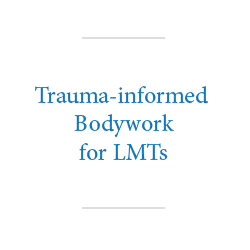
Essential Relational Skills
PCAB graduates are not required to take this course to receive the Trauma-informed certification.
Objectives: By the end of this course, participants will be able to:
- Describe the role of safety in a therapeutic setting.
- Be more aware of what makes it personally challenging to be present with another.
- Stay focused on the present moment in the midst of distracting thoughts.
- Distinguish between observations and imaginations.
- Be more comfortable with listening to a speaker without intervening.
- Track a client’s psychobiological shifts.
- Keep half of their attention on their own psychobiological condition while keeping half of their attention on the client.
- Describe the social-emotional value of mirroring.
- Utilize echo reflecting as a communication tool.
- Define attunement and resonance.
- Mirror a client’s breathing or sighs.
- Generate effective Contact Statements in response to what another says.
Advanced Trauma-informed Relational Skills
Neuroscience for Bodyworkers
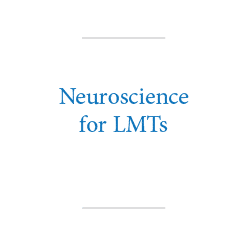 This professional development class for LMTs provides numerous insights about one’s practice from a neuroscience perspective. This course has two components: a video lecture series followed by a webinar series, each offered separately with the lecture series as a prerequisite for the webinar. Topics include:
This professional development class for LMTs provides numerous insights about one’s practice from a neuroscience perspective. This course has two components: a video lecture series followed by a webinar series, each offered separately with the lecture series as a prerequisite for the webinar. Topics include:- Neurocentric vs. Myocentric Perspectives
- Common Factors in Therapeutic Settings
- Neuroscience of Discriminative and Affective Touch
- Neuroscience of Acute and Chronic Pain
- Neuroscience of Explicit and Implicit Memory
- Neuroscience of Attention and Awareness
- Neuroscience of Interoception and Affect
- Neuroscience of Mindfulness and Agency
- Neuroscience of Trauma and Implicit Safety
- How Does Bodywork Work?
Cognitive Bias and Professional Development
 This professional development class for LMTs examines how cognitive biases affect our cognitive decision making processes as well as our political, interpersonal, and therapeutic relationships. Participants will learn to identify various cognitive biases and how to minimize their effects in oneself and others. This course has two components: a video lecture series followed by a webinar series, each offered separately with the lecture series as a prerequisite for the webinar. Some cognitive biases to be explored include:
This professional development class for LMTs examines how cognitive biases affect our cognitive decision making processes as well as our political, interpersonal, and therapeutic relationships. Participants will learn to identify various cognitive biases and how to minimize their effects in oneself and others. This course has two components: a video lecture series followed by a webinar series, each offered separately with the lecture series as a prerequisite for the webinar. Some cognitive biases to be explored include:- Confirmation Bias
- Backfire Effect
- Dunning-Kruger Effect
- Bias Blind Spot
- Loss Aversion
- Mere Exposure Effect
- Outgroup Homogeneity Bias and Trait Ascription Bias
- Impact Bias
- Regression Toward the Mean
- Just-world Phenomenon
- Implicit Bias
Cognitive Fallacies and Professional Development
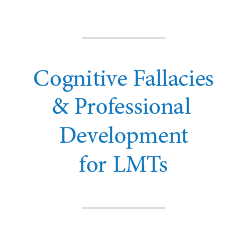 This professional development class for LMTs examines how cognitive fallacies affect our cognitive decision making processes as well as our political, interpersonal, and therapeutic relationships. Participants will learn to identify various cognitive fallacies and how to minimize their effects in oneself and others. This course has two components: a video lecture series followed by a webinar series, each offered separately with the lecture series as a prerequisite for the webinar. Some cognitive biases to be explored include:
This professional development class for LMTs examines how cognitive fallacies affect our cognitive decision making processes as well as our political, interpersonal, and therapeutic relationships. Participants will learn to identify various cognitive fallacies and how to minimize their effects in oneself and others. This course has two components: a video lecture series followed by a webinar series, each offered separately with the lecture series as a prerequisite for the webinar. Some cognitive biases to be explored include:- Ad hominem
- Straw Man
- False Cause
- Texas Sharpshooter
- Middle Ground
- Burden of Proof
- Appeal to Nature
- Argument by Gibberish
- Equivocation
- Anecdote
__________
Relational Skills for Depolarizing Conversations
 This class, which is open to anyone, explores how to navigate interpersonal conflicts. Various communication skills will be outlined and thoroughly practiced with co-participants. In addition, attention will be placed on common human values and how to maintain relationship by maintaining relational focus on these shared values. We will explore the values that underlie our sociopolitical beliefs and how to respectfully, compassionately, and effectively navigate discussions with others who have differing beliefs from oneself. Topics include:
This class, which is open to anyone, explores how to navigate interpersonal conflicts. Various communication skills will be outlined and thoroughly practiced with co-participants. In addition, attention will be placed on common human values and how to maintain relationship by maintaining relational focus on these shared values. We will explore the values that underlie our sociopolitical beliefs and how to respectfully, compassionately, and effectively navigate discussions with others who have differing beliefs from oneself. Topics include:- Interpersonal Fundamentals
- NVC Speaking
- Storytelling with Oneself
- NVC Listening
- Common Values
- Developmental Trauma
- Narcissism
- Intersubjectivity
- Seeding Doubt
- Aggression, Denial, Forgiveness, and Subjectivity
- Impossible Conversations
__________
Guided Muscle Visualization (Myotreks)
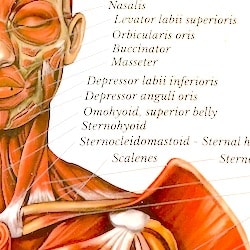 These audio recordings are great for helping to learn muscle attachments and their actions. By taking a fun “Magic School Bus” sort of journey through the body, one learns muscles by utilizing spatial memory, just as one would remember any other place one experienced. This works very well because human memory is much better suited for remembering places and spaces than it is for words and diagrams.Some students in our courses say that they learn muscles better this way than any other way. Topics include:
These audio recordings are great for helping to learn muscle attachments and their actions. By taking a fun “Magic School Bus” sort of journey through the body, one learns muscles by utilizing spatial memory, just as one would remember any other place one experienced. This works very well because human memory is much better suited for remembering places and spaces than it is for words and diagrams.Some students in our courses say that they learn muscles better this way than any other way. Topics include:
- Upper Body
- Lower Body
- Shoulder
- Hip
- Neck
- Flexors and Medial Rotators
- Extensors and Lateral Rotators
- Whole Body
__________
Guided Nervous System Visualization (Neurotreks)
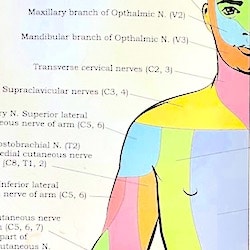 These audio recordings are great for helping to learn nerves, their general pathways, and their origin and termination points in the body, spinal cord, and brain. By taking a fun “Magic School Bus” sort of journey through the body, one learns the neural pathways by utilizing spatial memory and color memory, just as one would remember any other place one experienced. This works very well because human memory is much better suited for remembering places and spaces and color than it is for words and diagrams. Topics include:
These audio recordings are great for helping to learn nerves, their general pathways, and their origin and termination points in the body, spinal cord, and brain. By taking a fun “Magic School Bus” sort of journey through the body, one learns the neural pathways by utilizing spatial memory and color memory, just as one would remember any other place one experienced. This works very well because human memory is much better suited for remembering places and spaces and color than it is for words and diagrams. Topics include:- PNS<->CNS: Tactile/Interoceptive/Proprioceptive/Autonomic Afferents to Brain and Efferents to Body
- PNS Afferents-Trigeminal/Cervical
- PNS Afferents-Brachial
- PNS Afferents-Torso (Intercostal and Dorsal Rami)
- PNS Afferents-Lumbar
- PNS Afferents-Sacral
__________
Neuroscience of Mindfulness
This course examines the neuroscientific underpinnings for mindfulness, with specific focus on the functions of vision, memory, attention, interoception, emotion, personality, and behavior. Participants will gain a basic understanding of brain organization principles and will be introduced to conceptualizing human functioning from a neuroscientific perspective. Special focus is given to these topics as they integrate with bodywork, trauma, body awareness, meditation, and interpersonal relationships.
____________
Video Courses
Intro to Trauma-informed Care (2 hrs) |
|
A Neuroscience-based Approach to Chronic Pain(4 hrs) |
Trauma-informed Relational Skills Certification
Individuals must complete the previous online courses for certification in Trauma-informed Relational Skills:
- Essential Relational Skills (20 hours)
- The Neuroscience of Pain, Posture, and Bodywork (8 CE hours, NCBTMB approved)
- Trauma-informed Care (13 CE hours, NCBTMB approved)
- Relational Skills for Depolarizing Conversations (4 hours)
- Cognitive Biases (4 hours)
